Pelargonium caledonicum
Pelargonium caledonicum L.Bolus
Family: Geraniaceae
Common names: Caledon storksbill
Introduction
The conspicuous and unique Caledon Storksbill is one of South Africa’s most rare pelargoniums, only known to occur in the Caledon region of the Western Cape. This elegant plant blossoms in midsummer, producing pale pink flowers, with distinct, wine-red markings, that capture the eye.
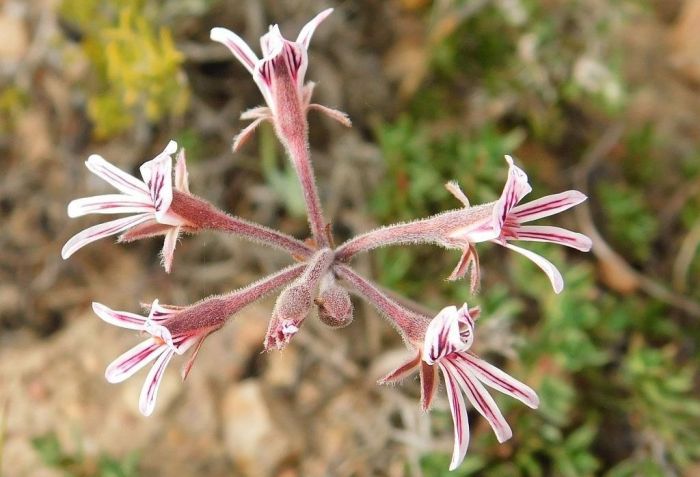
Description
Description
Pelargonium caledonicum is a deciduous geophyte that grows from an underground tuber; it flowers during the hot summer months then dies back until the first winter rains in April. This plant can grow up to 150 mm in height when flowering. The stem is an underground, branching structure, made up of hard tubers that are linked together and coated with peeling, brownish-black bark. The leaves are erect, pinnate or to some extent bipinnate and covered with long, soft hairs.
Pelargonium caledonicum develops an inflorescence that is a scape bearing up to 3 pseudo-umbels of 3–7 flowers, each with a stalk 35–60 mm long, that is also covered with soft hairs. The flowers have thin, obovate petals that are 14–16 mm long and 2.5–4.0 mm wide; pale pink, situated at less than 90 degrees from the center with attractive, wine-red, extended markings, reaching almost to the tips. Flowering is in midsummer, December to January.
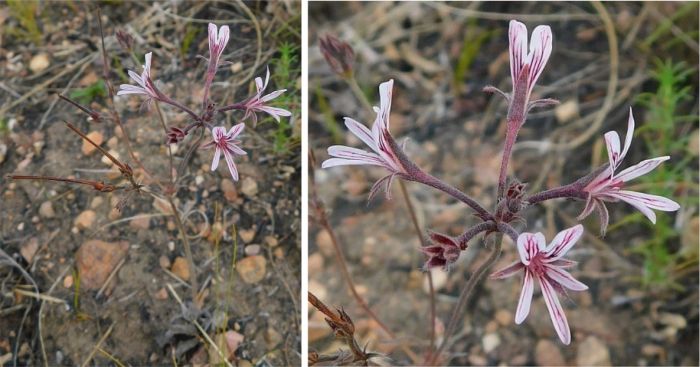
Conservation Status
Status
Pelargonium caledonicum is a rare species that has been assessed and flagged as Critically Endangered (CR) by the Red list of South African Plants. This is because it has lost nearly all of its habitat to wheat farms.
Based on habitat loss to wheat production during the last 90 years, a population drop of more than 80% is estimated (plants have a generation length 30 years). Due to continued expansion of wheat production, improper fire management, and alien plant invasion, only 8 small, extremely fragmented subpopulations persist on isolated habitat remnants and the numbers of wild plants continue to decline.
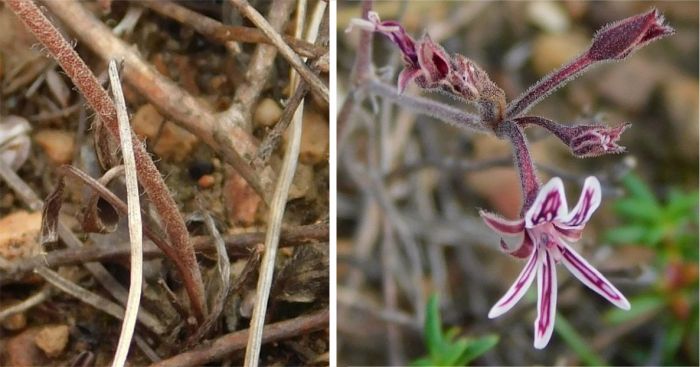
Distribution and habitat
Distribution description
Pelargonium caledonicum is endemic to South Africa. Although it is a well-defined species, its geographical range appears to be quite limited, as it is only known from a few scattered locations within in a 50 km radius of Caledon, situated in the Overberg region of the Western Cape, where it grows in Renosterveld, on loam soil derived from shale.
The Overberg is home to some of the most massive and well-preserved Renosterveld remnants, which include 4 severely, endangered plant types: Central Rûens Shale, Eastern Rûens Shale, Western Rûens Shale and Rûens Silcrete Renosterveld. Renosterveld, which is not particularly appealing for most of the year, shows its true colours during springtime when many of its plants bloom.
The region receives 400–600 mm of yearly rainfall, most of which falls as soft soaking drizzle over many days during the winter months. Summers are hot, while winters are mild, with light frost on occasion.
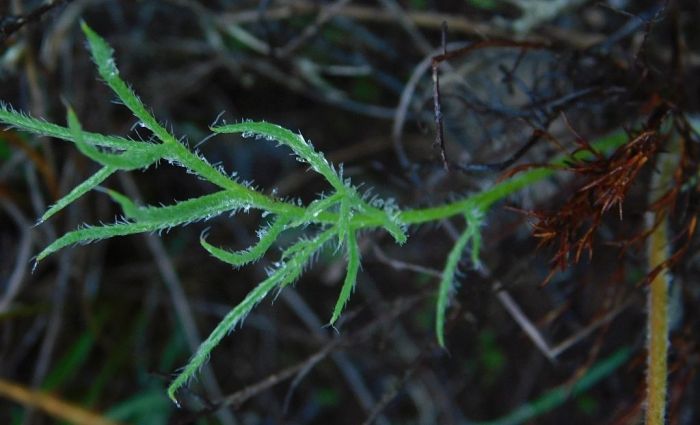
Derivation of name and historical aspects
History
The name Pelargonium is derived from the Greek word pelargos meaning ‘stork’, owing to the fruit's resemblance to the shape of a stork’s beak. The specific epithet caledonicum alludes to the village of Caledon, where this species was identified for the first time in the year 1930 by (H.M.L.) Louisa Bolus, a South African botanist and taxonomist.
Pelargonium is one of 5 genera that make up the Pelargonium family, known as the Geraniaceae. In southern Africa alone, there are around 250 species of Pelargonium. Geraniaceae is considered one of the distinctive families of the Cape Floristic Region. This is because the majority of Pelargonium species are found in the Western Cape Province. Pelargonium caledonicum belongs in section Hoarea, the largest section within the genus, with more than 50 identified species. Hoareas are all deciduous geophytes, with tubers covered with dark brown tunics, that flower once a year.
Geraniaceae is a global family found in temperate and tropical regions, such as southern, eastern, and northeastern Africa, Australia, New Zealand, St Helena, Tristan da Cunha, Madagascar, and Asia. Southern Africa, which is home to more than 80% of the species, is recognized as the worldwide hotspot for Pelargonium. The greatest variety among members of this family may be found in the western and southern regions of South Africa, as well as in Namaqualand.
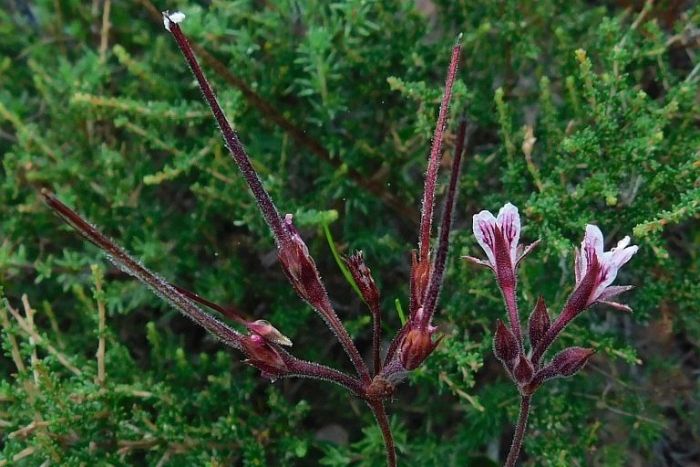
Ecology
Ecology
Pelargonium caledonicum grows and flowers best after its habitat has been subjected to fire. A number of other bulbous or tuberous plants that grow in fynbos and renosterveld share this feature. Germination is most favourable in the first and second season after fire. This species has difficulties flowering in over populated areas, where they have to compete with other plants or dead grass. Pelargonium caledonicum flowers are regularly visited by bees to collect pollen but they can also self-pollinate.
The Western Cape is well known for its many wheat and wine farms, which use extensive areas of land. Hoareas in pastoral settings, where many species grow, have adapted to these land use patterns. The numbers of individuals in separate populations varies in Hoareas, as it does in most other South African plants. Drought, fire and grazing pressures and patterns are the key elements that govern this. Drought is a common occurrence in South Africa and it is an important factor for geophytic pelargoniums. Drought appears to improve the seed bank, according to some studies. This could speed up the germination process.

Uses
Use
This species is critically rare and no medicinal or cultural uses have been recorded. However, it can make a good pot plant and can be used ornamentally in a garden, best planted amongst grasses and low-growing plants, but be sure to buy plant material from licensed, ethical growers.
Growing Pelargonium caledonicum
Grow
It is very easy to grow Pelargonium caledonicum from seeds and vegetatively from division of tubers. Plants must be grown in well-drained, loamy soil or in a medium with a low clay component. During the winter months, from May to September, plants need constant watering. They should also be irrigated on a regular basis throughout the summer months on cooler afternoons.
Seeds should be planted slightly beneath the surface of the soil in autumn (April and early May). Water seedlings throughout the winter and gradually let them dry off when the leaves wither and the plants display signs of entering dormancy.
References
- Craib, C. 2001. Geophytic pelargoniums field and cultivation studies of Pelargonium section Hoarea. Umdaus Press, Hatfield, Pretoria.
- Huxley, A. 1992. The new RHS dictionary of gardening. MacMillan Press, London.
- Manning, J. & Goldblatt, P. 2012. Plants of the Greater Cape Floristic Region 1: the Core Cape Flora. Strelitzia 29. South African National Biodiversity Institute, Pretoria.
- Marais, E.M. 1994. Taxonomic studies in Pelargonium, section Hoarea (Geraniaceae). Unpublished Ph.D. Thesis, University of Stellenbosch, Stellenbosch.
- Pywell, L. 2017. Flora of the Overberg. https://www.overberg-info.co.za/region/article/1144/flora-of-the-overberg. Accessed on 2021/09/06.
- Raimondo, D. & von Staden, L. 2016. Pelargonium caledonicum L.Bolus. National Assessment: Red List of South African Plants version 2020.1. Accessed on 2021/09/06
- Stearn, W. 2002. Stearn's dictionary of plant names for gardeners. Timber Press, Portland, Oregon.
- Van der Walt, J J A. 1977. Pelargoniums of South Africa. Purnell, Cape Town.
- Webb, J.W. 1984. The Pelargonium family. Croom Helm, London.
Credits
Sithandokuhle Wendy Ngcongo
Western Cape Department of Agriculture Intern
Kirstenbosch National Botanical Garden
October 2021
Acknowledgements: the author thanks Mr Enos Ramaepadi for his insights and support, and Mr Klaus Wehrlin for the images.
Plant Attributes:
Plant Type: Shrub
SA Distribution: Western Cape
Soil type: Sandy, Loam
Flowering season: Early Summer, Late Summer
PH: Acid
Flower colour: Pink
Aspect: Full Sun
Gardening skill: Average
Special Features:
Horticultural zones








Rate this article
Article well written and informative
Rate this plant
Is this an interesting plant?
Login to add your Comment
Back to topNot registered yet? Click here to register.